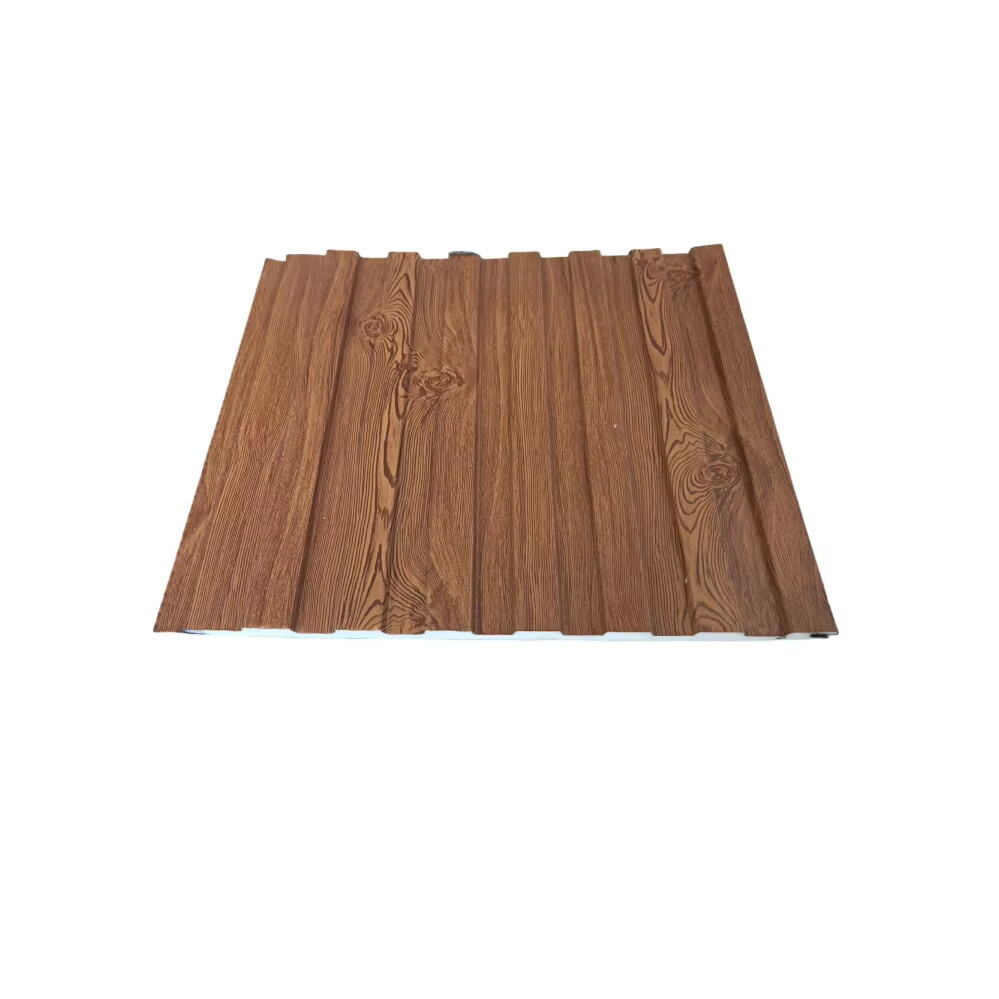Introduction to Polyurethane Sandwich Panel Installation
Why Proper Installation Matters for Efficiency
Proper installation is crucial in unlocking the full thermal efficiency of Polyurethane Sandwich Panels. When these panels are correctly installed, they achieve their intended insulation performance, leading to significant energy savings. This efficient insulation minimizes heat transfer, thereby maintaining comfortable interior temperatures throughout the year. In turn, this reduces the strain on heating and cooling systems and prolongs the life of building structures. On the contrary, incorrect installation can have detrimental effects, leading to air leakages that compromise energy efficiency. This can result in increased heating and cooling costs. Research indicates that proper sealing of building materials can reduce energy expenses by as much as 30%, making proper installation a key consideration for energy-conscious builders. Thus, ensuring precise installation is a proactive step toward sustainability and cost-efficiency in building management.
Key Benefits of Polyurethane Sandwich Panels
Polyurethane sandwich panels are highly appreciated for their excellent insulation properties, making them a wise choice for energy-conscious building owners. These panels contribute to reduced energy consumption, subsequently lowering utility bills. Besides, their lightweight nature paired with structural strength facilitates easier handling and quicker installation compared to more traditional materials, streamlining construction timelines. Additionally, these panels show impressive resistance to moisture and pest infiltration, which enhances their durability and lifespan. With such attributes, polyurethane sandwich panels offer a long-term cost-effective solution for modern construction needs, mitigating repair and maintenance expenses over time. Embracing these panels not only improves building efficiency but also supports a sustainable approach to construction.
Pre-Installation Preparation
Site Assessment for Structural Compatibility
A thorough site assessment is a vital step in ensuring the structural compatibility of polyurethane sandwich panels with the existing building framework. This involves checking the structural integrity to ensure that the framework can support the weight and load-bearing demands of the panels. It's equally important to evaluate environmental factors such as wind load, thermal movement, and seismic conditions, which are crucial for the safe installation and long-term performance of the panels. In addition, maintaining precise documentation of these assessments can streamline the process of acquiring necessary building permits and complying with local building codes. Proper documentation ensures that all regulatory and safety standards are met, facilitating a smoother installation process and longevity of the building structure.
Selecting the Right Panel Thickness & Insulation Grade
Choosing the correct panel thickness and insulation grade is critical for achieving the desired insulation efficiency. Different climate zones require varying thickness levels, affecting the panel's ability to maintain energy efficiency. By analyzing the R-value requirements, stakeholders can determine the optimal insulation grade, which can significantly enhance the energy efficiency of the building. Collaboration with insulation experts is advised, as they provide valuable insights tailored to specific project needs and local regulations. This partnership ensures that the selected panels contribute effectively to energy savings and meet the environmental and building standards pertinent to the area.
Essential Tools and Safety Equipment
Identifying necessary tools and ensuring their availability is crucial for a smooth installation process of polyurethane sandwich panels. Essential tools include a panel lifter for easy handling, cutting equipment for precise panel customization, and sealing applicators for creating airtight seals. Equally important is the use of personal protective equipment (PPE) such as gloves, goggles, and hard hats to ensure the safety of workers throughout the installation. A well-prepared checklist that includes both tools and safety gear can serve as a valuable resource, ensuring that all equipment is available and in good condition before installation begins. This preparation not only enhances the efficiency of the installation process but also prioritizes the safety of the construction team.
Surface Preparation Techniques
Cleaning and Leveling Substrate Surfaces
Effective surface preparation is crucial for the successful installation of polyurethane sandwich panels. It involves thorough cleaning to remove dirt, debris, and contaminants, which can interfere with the adhesive bond and reduce installation quality. Equally important is leveling the substrate, which promotes uniform load distribution and minimizes the risk of structural failure. This leveling enhances the longevity and stability of the sandwich panel installation. Additionally, using the correct leveling techniques is vital, as it not only supports structural integrity but also maximizes panel insulation properties, ensuring that each panel fits tightly for optimal thermal performance.
Addressing Moisture and Thermal Bridge Risks
Handling moisture and thermal bridge risks is key to extending the lifespan and efficiency of polyurethane sandwich panels. Addressing moisture issues prior to installation prevents mold growth and structural damage, safeguarding the integrity of the panels. Similarly, thermal bridging can significantly undermine insulation values; thus, design strategies that reduce or eliminate these risks should be prioritized. A practical approach involves utilizing vapor barriers and ensuring meticulous sealing during the installation process. These measures mitigate moisture infiltration and thermal bridging, ensuring the panels perform to their full potential in terms of energy efficiency and durability.
Panel Handling and Alignment Best Practices
Safe Lifting and Positioning Methods
Implementing safe lifting and positioning methods ensures that heavy panels are moved without causing harm to the workers or damaging the panels themselves. To achieve this, companies should utilize proper lifting techniques, such as forming teams for carrying tasks or employing mechanical aids, to prevent injuries and enhance the maneuverability of the panels. Training workers in safe handling practices is crucial for reducing workplace accidents, which can lead to improved installation speed. Additionally, using guides and markings during installation can ensure that panels are positioned accurately, minimizing errors and maintaining high safety standards throughout the process.
Ensuring Proper Joint Alignment for Seamless Installation
Achieving proper joint alignment is essential for minimizing gaps that could compromise the building's energy performance by allowing air and water infiltration. This is particularly important for ensuring the seamless integration of Polyurethane Sandwich Panels in construction Projects. Utilizing tools like laser levels and reference points can facilitate precise alignment of the panels during installation, ensuring that each joint is correctly connected. Developing a systematic installation plan further enhances this process by allowing for better coordination and alignment of joint connections, thereby ensuring that the installed panels deliver optimal thermal efficiency and integrity over their lifespan.
Fastening Systems and Air-Tight Sealing
Choosing Mechanical vs. Adhesive Fasteners
Selecting the right fasteners is crucial for optimizing installation techniques in different projects. Mechanical fasteners are often chosen for their immediate load-bearing capacity, providing a robust connection that does not require curing time. In contrast, adhesive fasteners can enhance thermal performance by reducing thermal bridging, which is critical in maintaining energy efficiency. When making a choice between these systems, it is important to consider manufacturer guidelines and local building codes to ensure compatibility and compliance with safety standards. By weighing the pros and cons of each fastening method, one can achieve optimal installation results tailored to specific project requirements.
Weatherproof Sealant Application for Joints and Edges
Applying weatherproof sealants correctly at panel joints and edges is vital to preventing moisture ingress and ensuring long-term durability. Using the appropriate techniques, such as ensuring even application and accounting for material expansion, is necessary to avoid issues like shrinkage or cracking over time. It is also beneficial to test sealants under various environmental conditions to determine their suitability for specific applications. This approach not only enhances the durability of the installation but also provides a reliable seal against water and weather elements, contributing to the overall integrity and lifespan of the building structure.
Preventing Air Infiltration at Connection Points
Effective sealing of connection points is essential to prevent air infiltration, which can significantly impact energy efficiency and indoor climate control. Any gaps can lead to unwanted air exchange, resulting in increased energy consumption to maintain desired temperature levels. Regular inspections following installation can help identify potential leakage points early, allowing for timely rectification. Emphasizing the importance of sealing through energy loss quantification provides a clear understanding of how meticulous installation can lead to improved energy retention and reduced operational costs. By focusing on these critical areas, installers can achieve optimal performance and sustainability for building constructions.
Frequently Asked Questions (FAQs)
How do Polyurethane Sandwich Panels improve energy efficiency?
When correctly installed, Polyurethane Sandwich Panels enhance energy efficiency by minimizing heat transfer, maintaining comfortable interior temperatures, and reducing the strain on heating and cooling systems.
Why is site assessment important for Polyurethane Sandwich Panel installation?
Site assessment ensures the structural compatibility of the panels with the existing framework, evaluates environmental factors, and facilitates compliance with safety standards and building codes.
What safety equipment is necessary during the installation process?
Personal protective equipment such as gloves, goggles, and hard hats are essential to ensure the safety of workers during the installation process.
How does proper joint alignment affect building energy performance?
Proper joint alignment minimizes gaps that can cause air and water infiltration, crucially maintaining the building's energy performance and thermal efficiency.
What are the advantages of using adhesive fasteners over mechanical ones?
Adhesive fasteners reduce thermal bridging, enhancing thermal performance and energy efficiency, although they require curing time compared to mechanical options.
Table of Contents
- Introduction to Polyurethane Sandwich Panel Installation
- Pre-Installation Preparation
- Surface Preparation Techniques
- Panel Handling and Alignment Best Practices
- Fastening Systems and Air-Tight Sealing
-
Frequently Asked Questions (FAQs)
- How do Polyurethane Sandwich Panels improve energy efficiency?
- Why is site assessment important for Polyurethane Sandwich Panel installation?
- What safety equipment is necessary during the installation process?
- How does proper joint alignment affect building energy performance?
- What are the advantages of using adhesive fasteners over mechanical ones?

 EN
EN







































